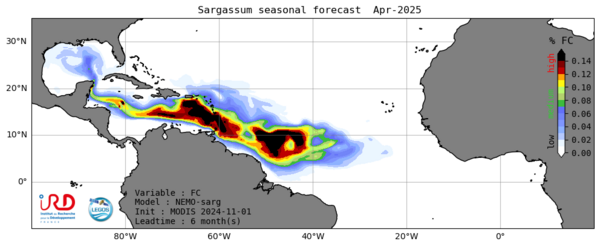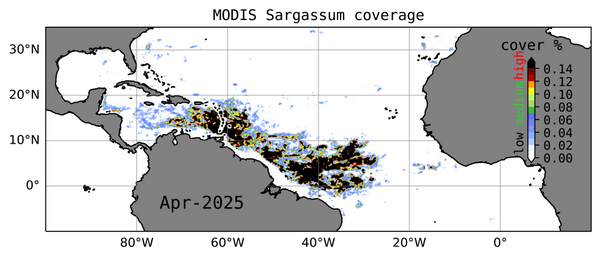Forecasting Sargassum over the next season
Image of the Month - June 2025
Sargassum algae presence in the Atlantic Ocean is not new - the center of the North Atlantic Gyre was called 'Sargassum Sea' after Christopher Colombus' journey to the Americas. Their importance in biodiversity have been assessed, including their role in the first year of life of sea turtles. However, for about 15 years, massive stranding on the coasts of the Caribbean and of West Africa have been observed (more than ten million tonnes in certain months in the Caribbean). They come from colossal quantities of algae drifting from the central tropical Atlantic between 0 and 15°N. When stranded, the algae decompose quickly, emanating noxious gases, which severely impact coastal communities, public health, tourism, and fisheries.
Open ocean observations of sargassum algae floating mats have been made thanks to satellites (Sentinel-3A&B, Aqua, Terra...) for several years now, thus enabling short-term stranding risks assessment. But longer-term forecasts are needed to better prepare mitigation and resilience strategies.
An IRD / Legos team developed a seasonal forecasting model for sargassum using observations, knowledge of the algae physiology and forecasts of physical data to predicts their abundance and location in the Atlantic ocean up to seven months in advance. The model forecasts are close to the actual satellite observation over the open ocean, even several months in advance. Stranding forecasts proper will need very local information, at the scales of bays, lagoons and open beaches, and a higher resolution model.
See also:
- Image of the Month, June 2022: Sargassum in the Loop current
- Applications: Oceanography / multi-sensors
- Applications: Biology
- Data: Sargassum products including the new Sargassum Seasonal Forecast product
Reference
- Jouanno, J., Morvan, G., Berline, L., Benshila, R., Aumont, O., Sheinbaum, J., & Ménard, F. (2023). Skillful seasonal forecast of Sargassum proliferation in the Tropical Atlantic. Geophysical Research Letters, 50, e2023GL105545. https://doi.org/10.1029/2023GL105545







